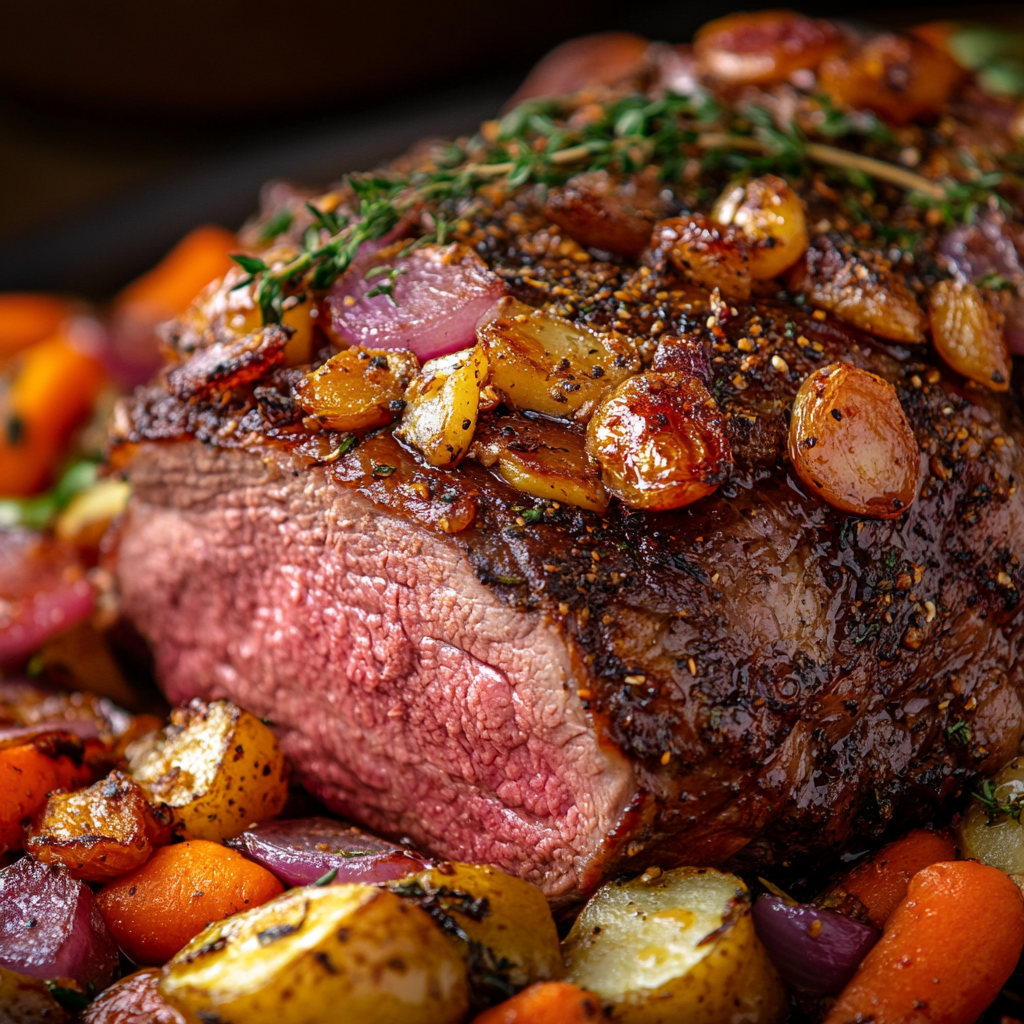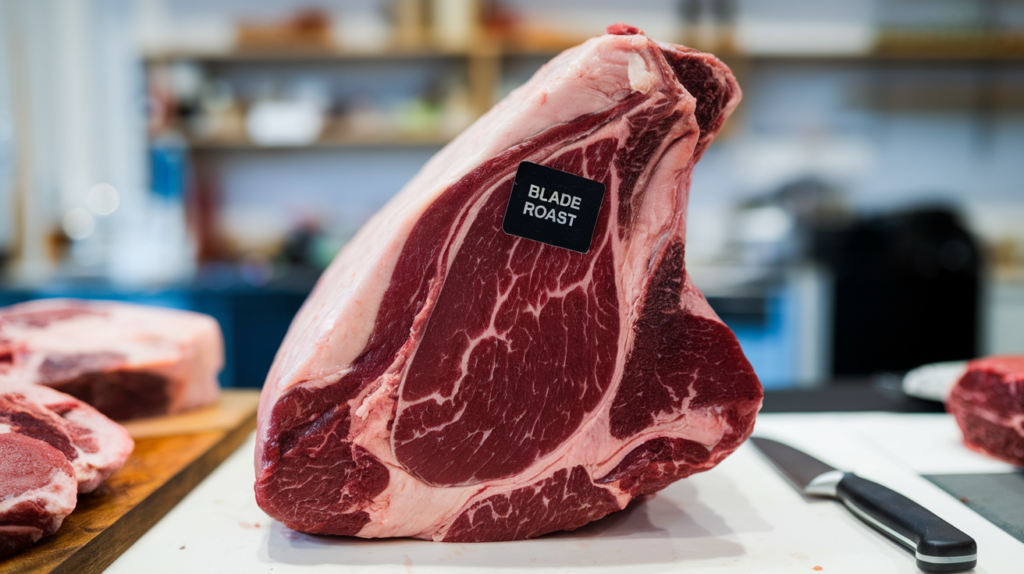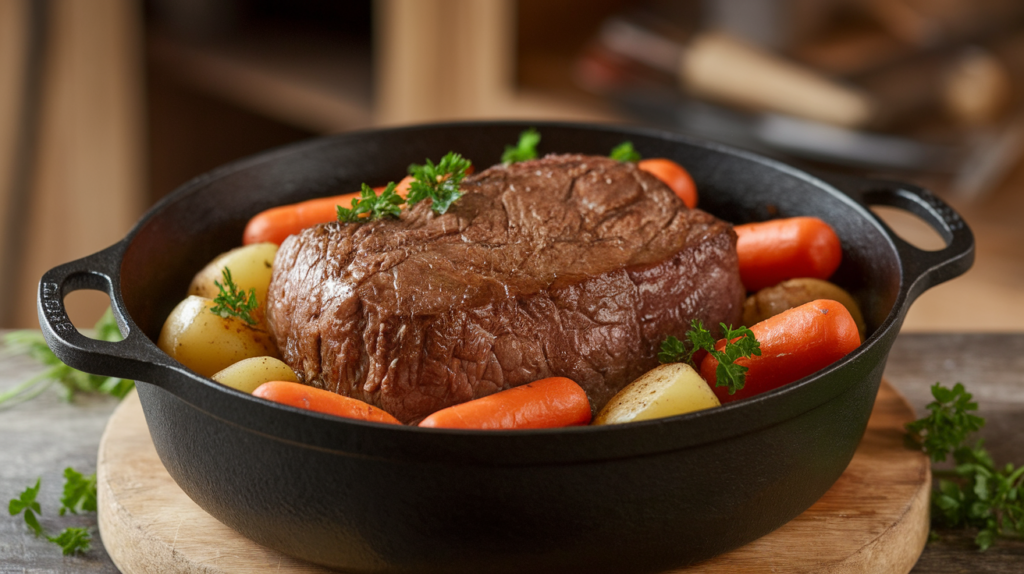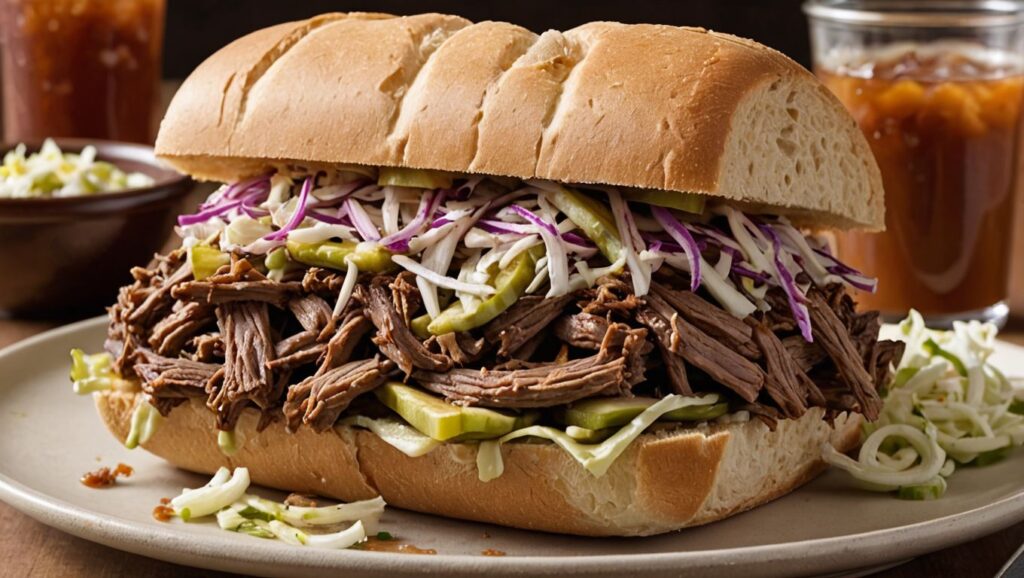
When it comes to cooking hearty, flavorful meals, few cuts of beef are as versatile and rewarding as the beef shoulder roast. Known for its rich taste, tender texture, and affordability, this cut is a favorite among chefs and home cooks alike. Whether you’re slow-cooking a pot roast or preparing a gourmet dish, the beef shoulder roast, especially its primele cuts, offers endless culinary possibilities.
But what exactly makes this cut so special? How do you choose, prepare, and cook it to perfection? In this comprehensive guide, we’ll explore everything you need to know about beef shoulder roast, from understanding its characteristics to mastering its preparation and cooking. Let’s dive in!
What Is a Beef Shoulder Roast?
The beef shoulder roast is a cut taken from the shoulder area of the cow, also known as the chuck. It is prized for its marbling, which provides flavor and moisture, making it ideal for slow-cooking methods. While it may not be as tender as pricier cuts like ribeye or filet mignon, its robust flavor and versatility make it a must-have for hearty meals.
Primele Cuts: What Makes Them Special?
The term “primele” refers to premium selections within a specific beef cut, often chosen for their superior marbling, texture, and flavor. When applied to beef shoulder roasts, primele cuts offer a balance of tenderness and richness that elevates any recipe. These cuts are perfect for slow cooking, braising, or roasting, unlocking the beef’s full potential.
Types of Beef Shoulder Roasts
The beef shoulder is a versatile section of the cow, offering several roast options, each with unique qualities. Understanding these types will help you choose the perfect cut for your recipe and cooking method.
Blade Roast: A Classic Favorite
The blade roast is one of the most well-known cuts from the beef shoulder. It is named after the blade bone it contains and is recognized for its:
- Marbling: Rich veins of fat that melt during cooking, ensuring a moist and flavorful result.
- Texture: While it’s not as naturally tender as a filet, slow-cooking methods bring out its soft, melt-in-your-mouth texture.
- Uses: Ideal for pot roasts, stews, and braised dishes.
Blade roasts are perfect when you’re looking for a cut that delivers both flavor and value.
Chuck Roast: The Versatile Cut
The chuck roast is perhaps the most versatile cut from the shoulder, known for its rich, beefy flavor.
- Characteristics: Boneless with a good balance of meat and fat, making it ideal for recipes requiring long cooking times.
- Flavor Profile: Slightly fattier than the blade roast, enhancing its juiciness and depth of taste.
- Popular Dishes: Slow-cooked shredded beef for tacos, hearty pot roasts, or even a classic beef stew.
Its adaptability makes it a staple in many kitchens.
Arm Roast: A Tender Option
The arm roast is another exceptional choice, taken from the lower part of the shoulder. It is leaner than other shoulder roasts but still offers fantastic flavor when cooked properly.
- Texture: With a fine grain, it becomes tender and delicious after slow roasting or braising.
- Best Cooking Methods: Braising in liquids like beef broth or wine helps to maintain its tenderness and flavor.
- Serving Ideas: Sliced thin for sandwiches or paired with roasted vegetables for a wholesome meal.
Benefits of Choosing Primele Cuts
When it comes to beef shoulder roasts, selecting primele cuts is a smart choice for home cooks and chefs alike. These premium selections offer numerous advantages, from exceptional taste to cost-effectiveness, making them an ideal choice for a variety of recipes.
Nutritional Value
Beef shoulder roasts are not just flavorful but also packed with nutrients. Choosing primele cuts ensures you’re getting the best quality meat with plenty of health benefits.
- Protein Powerhouse: High in protein, beef shoulder roast supports muscle building and repair.
- Rich in Vitamins and Minerals: Contains essential nutrients like Vitamin B12, zinc, and iron, which are crucial for energy production and a healthy immune system.
- Fat Content: The marbling in primele cuts contributes to flavor but also includes healthy fats when consumed in moderation.
For those seeking a nutrient-dense addition to their meals, primele cuts are a fantastic choice.
Rich Flavor and Tenderness
The hallmark of a primele cut is its superior marbling. This natural distribution of fat within the meat enhances:
- Juiciness: Keeps the roast moist even during long cooking processes.
- Flavor: Adds depth and complexity, making dishes irresistibly savory.
- Tender Texture: When prepared properly, primele cuts yield fork-tender meat, perfect for hearty meals.
Cost-Effectiveness
Primele cuts offer a unique advantage over more expensive beef options:
- Affordable Gourmet Quality: They deliver premium taste and texture without breaking the bank.
- Versatility: These cuts work well across various cooking methods, from slow cooking to roasting, maximizing value for money.
- Leftover Potential: Large cuts often produce leftovers that can be repurposed into dishes like sandwiches, tacos, or soups, reducing waste and stretching your budget further.
How to Select the Best Beef Shoulder Roast

Choosing the right beef shoulder roast is the first step toward creating a mouthwatering meal. From understanding freshness to deciphering beef grades, knowing what to look for ensures that your primele cut delivers the best flavor and quality.
Signs of Freshness
When shopping for a beef shoulder roast, keep an eye out for these signs of freshness to ensure you’re getting a top-quality cut:
- Color: Look for a bright, cherry-red hue. Avoid meat that appears dull, gray, or brown, as it may be past its prime.
- Texture: The meat should feel firm to the touch, with no slimy or sticky residue.
- Smell: Fresh beef should have a mild scent. A strong, unpleasant odor is a red flag.
- Packaging: Check for tightly sealed packaging with no tears or excessive liquid, which can indicate improper storage or aging.
Freshness is key to achieving the best flavor and texture in your roast.
Grades of Beef: Understanding USDA Ratings
The USDA grading system helps consumers determine the quality of beef. For shoulder roasts, understanding these grades ensures you get the best possible cut:
- Prime Grade: The highest grade, offering excellent marbling and tenderness. Ideal for gourmet dishes.
- Choice Grade: A step down from prime, but still very flavorful with good marbling. It’s more affordable and widely available.
- Select Grade: Leaner and less marbled, this grade is better for recipes requiring tenderizing methods, like slow cooking or marinating.
Choosing USDA Prime or Choice grade for your shoulder roast ensures a tender and juicy result.
Choosing Between Grass-Fed and Grain-Fed
The diet of the cow significantly impacts the flavor, texture, and nutritional profile of the meat. Here’s how grass-fed and grain-fed options compare:
- Grass-Fed Beef:
- Rich, earthy flavor with a slightly leaner profile.
- Higher in omega-3 fatty acids and antioxidants like Vitamin E.
- Often considered the more sustainable choice.
- Grain-Fed Beef:
- Milder, buttery flavor with more pronounced marbling.
- Higher in fat content, contributing to juiciness and tenderness.
- Typically more affordable and widely available.
The choice between grass-fed and grain-fed depends on your taste preferences and dietary goals.
Preparing a Beef Shoulder Roast
Proper preparation is crucial for getting the most out of your beef shoulder roast. From having the right tools to mastering trimming and seasoning techniques, these steps ensure your roast is ready for cooking and full of flavor.
Essential Kitchen Tools
Before you start, make sure you have these essential tools on hand:
- Sharp Chef’s Knife: For precise trimming and cutting.
- Cutting Board: A sturdy surface to handle the roast safely.
- Meat Thermometer: Ensures accurate cooking temperatures for perfectly cooked beef.
- Roasting Pan or Dutch Oven: Ideal for slow roasting or braising.
- Tongs: For handling the meat without piercing it and losing valuable juices.
These tools make preparation and cooking a breeze, ensuring professional-level results at home.
Trimming the Roast
While beef shoulder roasts are known for their flavor-packed marbling, some trimming may be necessary for the best results:
- Remove Excess Fat: Trim any large, thick fat caps to prevent uneven cooking.
- Silver Skin: Carefully remove the silver skin (a tough, shiny membrane) to improve tenderness.
- Uniform Shape: Trim to ensure the roast is evenly shaped for consistent cooking.
Trimming enhances the texture and presentation of your roast, while also reducing excess grease.
Seasoning the Roast
Seasoning is where the magic begins. A well-seasoned beef shoulder roast lays the foundation for a delicious meal. Here’s how to do it right:
- Basic Seasoning: Start with a simple blend of salt and freshly ground black pepper to highlight the natural beef flavors.
- Herbs and Spices: Add layers of flavor with rosemary, thyme, garlic powder, paprika, or cumin.
- Marinades: For added moisture and tang, marinate the roast in a mixture of olive oil, vinegar, and your choice of spices for 4–12 hours.
- Dry Rub: For a bold crust, use a dry rub of brown sugar, smoked paprika, chili powder, and ground mustard.
Rub the seasoning generously into all sides of the roast, ensuring it is evenly coated.
Cooking Methods for Beef Shoulder Roast
Cooking a beef shoulder roast to perfection requires choosing the right method to match the cut’s characteristics. Slow cooking, oven roasting, and pressure cooking are three tried-and-true techniques that maximize flavor and tenderness. Here’s a detailed guide to each method.
Slow Cooking: Unlocking Deep Flavors
Slow cooking is a foolproof way to bring out the rich, hearty flavors of a beef shoulder roast. This method allows the marbling to melt into the meat, resulting in a tender, juicy roast.
Steps for Slow Cooking:
- Preparation: Sear the roast in a hot skillet with a bit of oil to lock in the juices and create a flavorful crust.
- Add Ingredients: Place the roast in a slow cooker with beef broth, onions, carrots, potatoes, and seasonings like bay leaves, thyme, and garlic.
- Set the Cooker: Cook on low for 8–10 hours or high for 4–6 hours, ensuring the roast becomes fork-tender.
Benefits:
- Perfect for busy days just set it and forget it.
- Creates a one-pot meal with minimal cleanup.
Oven Roasting: The Traditional Approach
Oven roasting is a classic method that produces a flavorful, evenly cooked beef shoulder roast with a beautiful crust.
Steps for Oven Roasting:
- Preheat: Set your oven to 325°F (163°C).
- Sear the Roast: In a hot skillet, brown all sides of the roast to develop a crust.
- Prepare the Roasting Pan: Place the seared roast in a pan with vegetables, beef stock, and seasonings.
- Roast: Cover with foil or a lid and cook for 2.5–3 hours, depending on the roast’s size. Use a meat thermometer to check for doneness (target temperature: 195°F/90°C for shreddable tenderness).
- Rest: Let the roast rest for 15 minutes before slicing.
Benefits:
- Develops a caramelized exterior for added flavor.
- Ideal for creating a sauce or gravy from the pan drippings.
Pressure Cooking: A Time-Saving Solution
For those short on time, a pressure cooker is an excellent option for tenderizing a beef shoulder roast quickly while locking in flavors.
Steps for Pressure Cooking:
- Brown the Roast: Use the sauté function to sear the meat on all sides.
- Add Liquid and Ingredients: Add beef broth, onions, garlic, and your favorite spices to the pressure cooker.
- Cook: Seal the lid and cook on high pressure for 60–75 minutes, depending on the roast’s size.
- Release Pressure: Let the pressure release naturally for 10–15 minutes before opening.
- Shred or Slice: The roast should be tender enough to shred or slice easily.
Benefits:
- Cuts cooking time significantly.
- Retains moisture and intensifies flavors.
Recipe Ideas Using Beef Shoulder Roast

A beef shoulder roast is incredibly versatile, lending itself to a wide range of mouthwatering recipes. From comforting classics to creative modern dishes, here are some delicious ideas to inspire your next culinary adventure.
Classic Pot Roast
A timeless favorite, pot roast is the ultimate comfort food that highlights the tender, flavorful qualities of a beef shoulder roast.
Ingredients:
- 3–4 lb beef shoulder roast
- 2 cups beef broth
- 4 carrots, peeled and chopped
- 4 potatoes, quartered
- 2 onions, sliced
- 3 garlic cloves, minced
- Salt, pepper, thyme, and bay leaves to taste
Instructions:
- Sear the Roast: In a large skillet, brown the roast on all sides.
- Prepare the Pot: Place the roast in a Dutch oven or slow cooker with broth, vegetables, and seasonings.
- Cook: Bake at 325°F (163°C) for 3 hours (or cook in a slow cooker on low for 8–10 hours).
- Serve: Slice the roast and serve with the vegetables and pan juices.
Pulled Beef Sandwiches
Turn your beef shoulder roast into succulent shredded beef for sandwiches that are perfect for a casual meal or party.
Ingredients:
- 3 lb beef shoulder roast
- 1 cup BBQ sauce
- 1 onion, chopped
- 2 cups beef broth
- Sandwich buns
Instructions:
- Cook the Roast: Slow cook or pressure cook the roast with onions and broth until tender.
- Shred the Beef: Use two forks to pull the beef apart.
- Mix with Sauce: Combine shredded beef with BBQ sauce in a skillet and heat gently.
- Assemble: Pile the beef onto buns and top with coleslaw for added crunch.
Beef Shoulder Tacos
Give your beef shoulder roast a Tex-Mex twist with this fun and flavorful recipe.
Ingredients:
- 2 lb beef shoulder roast
- 1 packet taco seasoning
- 1 cup beef broth
- Soft tortillas
- Toppings: shredded cheese, lettuce, salsa, sour cream, and avocado
Instructions:
- Season the Roast: Rub the roast with taco seasoning.
- Cook: Braise in beef broth in a slow cooker or Dutch oven until tender.
- Shred the Beef: Use forks to pull apart the beef.
- Assemble Tacos: Fill tortillas with shredded beef and your favorite toppings.
Additional Recipe Variations
- Beef and Vegetable Stew: Combine chunks of beef shoulder roast with root vegetables, herbs, and broth for a hearty stew.
- Beef Shoulder Shepherd’s Pie: Layer shredded beef with mashed potatoes and bake until golden brown.
- Asian-Style Braised Beef: Cook the roast with soy sauce, ginger, and garlic for a savory twist.
Frequently Asked Questions (FAQs) About Beef Shoulder Roast
Here are answers to some of the most common questions about beef shoulder roast, ensuring you can prepare and enjoy this versatile cut with confidence.
What is the difference between chuck roast and shoulder roast?
Although both cuts come from the shoulder region of the cow, there are distinct differences:
- Chuck Roast:
- Contains more marbling, making it richer in flavor and juicier.
- Ideal for slow cooking or shredding.
- Slightly more tender than shoulder roast due to higher fat content.
- Shoulder Roast:
- Leaner and less marbled but still flavorful.
- Best for slicing after roasting or braising.
- Often more affordable than chuck roast.
How long does it take to cook a beef shoulder roast?
Cooking time depends on the method and size of the roast:
- Slow Cooker: 8–10 hours on low or 4–6 hours on high.
- Oven Roasting: Approximately 3 hours at 325°F (163°C) for a 3–4 lb roast.
- Pressure Cooking: 60–75 minutes on high pressure, plus natural release.
Always use a meat thermometer to check for doneness. For shreddable roasts, aim for an internal temperature of around 195°F (90°C).
Can I freeze cooked beef shoulder roast?
Yes, cooked beef shoulder roast freezes exceptionally well:
- Cool the Meat: Allow the roast to cool completely before freezing.
- Store Properly: Place the meat in airtight containers or freezer bags, removing as much air as possible.
- Label and Date: Mark the package with the date for easy tracking.
- Shelf Life: Cooked beef shoulder roast can be frozen for up to 3 months.
When ready to use, thaw in the refrigerator overnight and reheat gently.
What is the best way to reheat a beef shoulder roast?
To retain moisture and flavor, reheat your beef shoulder roast using one of these methods:
- Oven: Place in a covered dish with a bit of broth or gravy and heat at 300°F (150°C) until warmed through.
- Stovetop: Simmer gently in a skillet with some liquid.
- Microwave: Use medium power and cover the roast to prevent it from drying out.
Avoid overheating, as it can make the roast tough.
Can I marinate a beef shoulder roast overnight?
Absolutely! Marinating a beef shoulder roast overnight enhances its flavor and tenderness. Use a marinade with acidic components (like vinegar or citrus juice) along with your favorite herbs and spices. For best results, refrigerate the roast in a sealed bag or container while marinating.
What are some side dishes that pair well with beef shoulder roast?
Beef shoulder roast pairs beautifully with a variety of side dishes, including:
- Classic Mashed Potatoes: Creamy and comforting.
- Roasted Vegetables: Carrots, parsnips, and Brussels sprouts complement the roast’s richness.
- Grain Dishes: Wild rice or quinoa add texture and flavor.
- Salads: A crisp green salad with vinaigrette balances the meal.
Love cozy, flavorful meals like this? Follow for more heartwarming recipes and kitchen inspiration! Whether you’re pinning your next dinner idea or diving into food stories on Medium, there’s always something delicious waiting for you. 🍽️✨
Conclusion: Making the Most of Your Primele Cut

The beef shoulder roast, particularly primele cuts, is a true gem in the culinary world. Its rich flavor, versatility, and cost-effectiveness make it an excellent choice for hearty meals that bring families together. Whether you’re preparing a classic pot roast, crafting pulled beef sandwiches, or exploring creative recipes like tacos and Asian-inspired dishes, this cut delivers exceptional results every time.
By selecting a fresh, high-quality primele cut, using the right preparation techniques, and choosing the best cooking method for your recipe, you can transform a simple beef shoulder roast into a show-stopping centerpiece. With the insights and tips provided in this guide, you’re now ready to explore all the delicious possibilities this cut of beef has to offer.
Love cozy, flavorful meals like this? Follow for more heartwarming recipes and kitchen inspiration! Whether you’re pinning your next dinner idea or diving into food stories on Medium, there’s always something delicious waiting for you.
So, grab your favorite recipe and get cooking your perfect roast awaits!
Explore Related Recipes and Cooking Tips
- Discover quick cooking methods with the Fast Beef Brisket Recipe: A Quick and Delicious Guide.
- Learn about different beef cuts and recipes in The Ultimate Guide to Moo Shu Beef: History, Recipes, and Expert Tips.
- Enhance your knowledge of beef preparation with the Spinalis Steak Guide: The Ultimate Guide to the Ribeye Cap.
- Master steak cooking techniques with How to Cook Ranch Steak Perfectly Every Time.
Beef Shoulder Roast
Equipment
- Slow Cooker
- Roasting Pan
- Meat Thermometer
Ingredients
Beef Shoulder Roast
- 3 lb beef shoulder roast trimmed of excess fat
- 2 tbsp olive oil
- 1 tsp salt or to taste
- 1/2 tsp black pepper freshly ground
Vegetables & Broth
- 4 carrots peeled and chopped
- 4 potatoes quartered
- 2 onions sliced
- 3 cloves garlic minced
- 2 cups beef broth
- 1 tsp thyme dried or fresh
- 2 leaves bay leaves
Instructions
- Season the beef shoulder roast with salt and black pepper on all sides.
- Heat olive oil in a large skillet over medium-high heat. Sear the roast on all sides until browned (about 3-4 minutes per side).
- Transfer the roast to a slow cooker or roasting pan.
- Add chopped carrots, potatoes, onions, and garlic around the roast.
- Pour beef broth over the roast and vegetables. Add thyme and bay leaves.
- Cover and cook on low for 8-10 hours or on high for 4-6 hours (for slow cooker). If oven roasting, cover with foil and bake at 325°F (163°C) for 3 hours.
- Check doneness using a meat thermometer. The roast should reach an internal temperature of 195°F (90°C) for fall-apart tenderness.
- Remove from heat and let the roast rest for 10 minutes before slicing or shredding.

